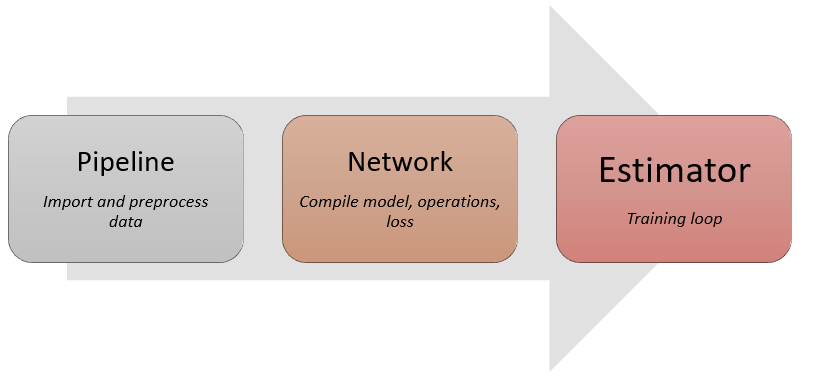Three main APIs¶
All deep learning training workflows involve the following three essential components, each mapping to a critical API in FastEstimator.
Data pipeline: extracts data from disk/RAM, performs transformations. ->
fe.PipelineNetwork: performs trainable and differentiable operations. ->
fe.NetworkTraining loop: combines the data pipeline and network in an iterative process. ->
fe.Estimator
Any deep learning task can be constructed by following the 3 main steps:

Image Classification Example¶
Step 1 - Pipeline¶
We use FastEstimator dataset API to load the MNIST dataset. Please check out Tutorial 2 for more details about the dataset API. In this case our data preprocessing involves:
- Expand image dimension from (28,28) to (28, 28, 1) for convenience during convolution operations.
- Rescale pixel values from [0, 255] to [0, 1].
Please check out Tutorial 3 for details about Operator and Tutorial 4 for Pipeline.
import fastestimator as fe
from fastestimator.dataset.data import mnist
from fastestimator.op.numpyop.univariate import ExpandDims, Minmax
train_data, eval_data = mnist.load_data()
pipeline = fe.Pipeline(train_data=train_data,
eval_data=eval_data,
batch_size=32,
ops=[ExpandDims(inputs="x", outputs="x"), Minmax(inputs="x", outputs="x")])
Step 2 - Network¶
The model definition can be either from tf.keras.Model or torch.nn.Module, for more info about network definitions, check out Tutorial 5. The differentiable operations during training are listed as follows:
- Feed the preprocessed images to the network and get prediction scores.
- Calculate
CrossEntropy(loss) between prediction scores and ground truth. - Update the model by minimizing
CrossEntropy.
For more info about Network and its operators, check out Tutorial 6.
from fastestimator.architecture.tensorflow import LeNet
# from fastestimator.architecture.pytorch import LeNet # One can also use a pytorch model
from fastestimator.op.tensorop.loss import CrossEntropy
from fastestimator.op.tensorop.model import ModelOp, UpdateOp
model = fe.build(model_fn=LeNet, optimizer_fn="adam")
network = fe.Network(ops=[
ModelOp(model=model, inputs="x", outputs="y_pred"),
CrossEntropy(inputs=("y_pred", "y"), outputs="ce"),
UpdateOp(model=model, loss_name="ce")
])
Step 3 - Estimator¶
We define the Estimator to connect the Network to the Pipeline, and compute accuracy as a validation metric. Please see Tutorial 7 for more about Estimator and Traces.
from fastestimator.trace.metric import Accuracy
from fastestimator.trace.io import BestModelSaver
import tempfile
traces = [Accuracy(true_key="y", pred_key="y_pred"),
BestModelSaver(model=model, save_dir=tempfile.mkdtemp(), metric="accuracy", save_best_mode="max")]
estimator = fe.Estimator(pipeline=pipeline,
network=network,
epochs=2,
traces=traces)
Start Training¶
estimator.fit()
______ __ ______ __ _ __
/ ____/___ ______/ /_/ ____/____/ /_(_)___ ___ ____ _/ /_____ _____
/ /_ / __ `/ ___/ __/ __/ / ___/ __/ / __ `__ \/ __ `/ __/ __ \/ ___/
/ __/ / /_/ (__ ) /_/ /___(__ ) /_/ / / / / / / /_/ / /_/ /_/ / /
/_/ \__,_/____/\__/_____/____/\__/_/_/ /_/ /_/\__,_/\__/\____/_/
FastEstimator-Start: step: 1; num_device: 1; logging_interval: 100;
FastEstimator-Train: step: 1; ce: 2.2944355;
FastEstimator-Train: step: 100; ce: 0.17604804; steps/sec: 724.9;
FastEstimator-Train: step: 200; ce: 0.6541523; steps/sec: 755.07;
FastEstimator-Train: step: 300; ce: 0.22645846; steps/sec: 793.02;
FastEstimator-Train: step: 400; ce: 0.1256088; steps/sec: 773.46;
FastEstimator-Train: step: 500; ce: 0.18927144; steps/sec: 809.2;
FastEstimator-Train: step: 600; ce: 0.07107867; steps/sec: 779.29;
FastEstimator-Train: step: 700; ce: 0.07468874; steps/sec: 806.57;
FastEstimator-Train: step: 800; ce: 0.23852134; steps/sec: 781.42;
FastEstimator-Train: step: 900; ce: 0.028577618; steps/sec: 826.27;
FastEstimator-Train: step: 1000; ce: 0.115206845; steps/sec: 776.94;
FastEstimator-Train: step: 1100; ce: 0.07892787; steps/sec: 841.47;
FastEstimator-Train: step: 1200; ce: 0.14857067; steps/sec: 791.73;
FastEstimator-Train: step: 1300; ce: 0.049252644; steps/sec: 834.86;
FastEstimator-Train: step: 1400; ce: 0.046725605; steps/sec: 799.79;
FastEstimator-Train: step: 1500; ce: 0.06713241; steps/sec: 812.31;
FastEstimator-Train: step: 1600; ce: 0.08489384; steps/sec: 803.99;
FastEstimator-Train: step: 1700; ce: 0.00921803; steps/sec: 767.87;
FastEstimator-Train: step: 1800; ce: 0.0072177458; steps/sec: 694.9;
FastEstimator-Train: step: 1875; epoch: 1; epoch_time: 2.97 sec;
FastEstimator-BestModelSaver: Saved model to /tmp/tmpcxa1xloj/model_best_accuracy.h5
FastEstimator-Eval: step: 1875; epoch: 1; ce: 0.06391551; accuracy: 0.9802; since_best_accuracy: 0; max_accuracy: 0.9802;
FastEstimator-Train: step: 1900; ce: 0.006937413; steps/sec: 419.42;
FastEstimator-Train: step: 2000; ce: 0.10369404; steps/sec: 769.67;
FastEstimator-Train: step: 2100; ce: 0.023126157; steps/sec: 787.83;
FastEstimator-Train: step: 2200; ce: 0.013664322; steps/sec: 807.29;
FastEstimator-Train: step: 2300; ce: 0.15465331; steps/sec: 782.67;
FastEstimator-Train: step: 2400; ce: 0.0059421803; steps/sec: 783.07;
FastEstimator-Train: step: 2500; ce: 0.03436095; steps/sec: 789.81;
FastEstimator-Train: step: 2600; ce: 0.003341827; steps/sec: 813.02;
FastEstimator-Train: step: 2700; ce: 0.009203151; steps/sec: 779.41;
FastEstimator-Train: step: 2800; ce: 0.0031451974; steps/sec: 818.42;
FastEstimator-Train: step: 2900; ce: 0.03497669; steps/sec: 789.2;
FastEstimator-Train: step: 3000; ce: 0.0043699713; steps/sec: 816.05;
FastEstimator-Train: step: 3100; ce: 0.14205246; steps/sec: 769.89;
FastEstimator-Train: step: 3200; ce: 0.00966863; steps/sec: 827.11;
FastEstimator-Train: step: 3300; ce: 0.005415355; steps/sec: 780.63;
FastEstimator-Train: step: 3400; ce: 0.027803676; steps/sec: 812.07;
FastEstimator-Train: step: 3500; ce: 0.3876436; steps/sec: 788.85;
FastEstimator-Train: step: 3600; ce: 0.011643453; steps/sec: 809.37;
FastEstimator-Train: step: 3700; ce: 0.20535453; steps/sec: 794.13;
FastEstimator-Train: step: 3750; epoch: 2; epoch_time: 2.46 sec;
FastEstimator-BestModelSaver: Saved model to /tmp/tmpcxa1xloj/model_best_accuracy.h5
FastEstimator-Eval: step: 3750; epoch: 2; ce: 0.03874958; accuracy: 0.9867; since_best_accuracy: 0; max_accuracy: 0.9867;
FastEstimator-Finish: step: 3750; total_time: 8.86 sec; model_lr: 0.001;
Inferencing¶
After training, we can do inferencing on new data with Pipeline.transform and Netowork.transform. Please checkout Tutorial 8 for more details. \
import numpy as np
data = eval_data[0]
data = pipeline.transform(data, mode="eval")
data = network.transform(data, mode="eval")
print("Ground truth class is {}".format(data["y"][0]))
print("Predicted class is {}".format(np.argmax(data["y_pred"])))
img = fe.util.ImgData(x=data["x"])
fig = img.paint_figure()
Ground truth class is 7 Predicted class is 7